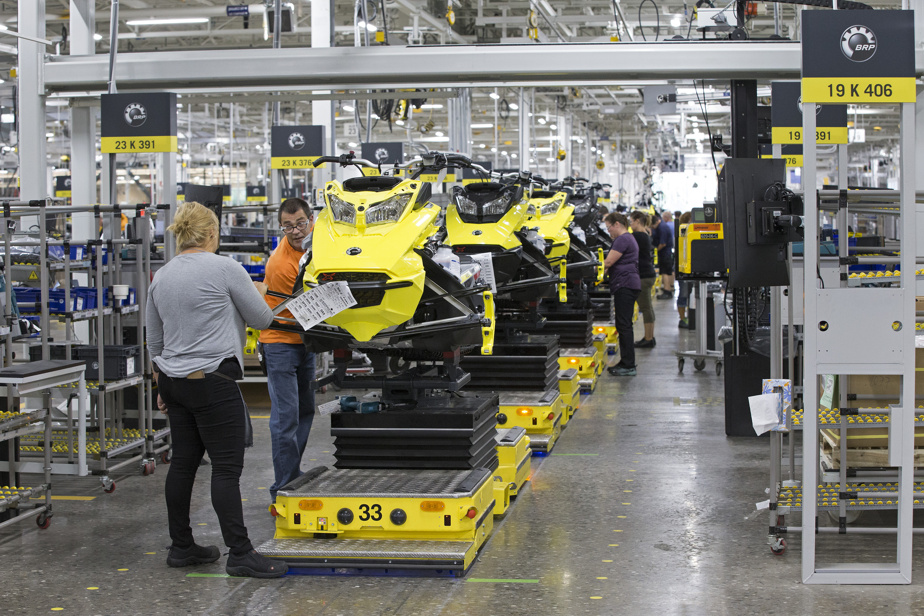BRP is slowing down in its factories – especially on the snowmobile side – because its recreational vehicles are selling slower than during the pandemic. This slowdown is felt as far as Valcourt, in Estrie, where we will need 300 “fewer” people to assemble Ski-Doos this year.
The thinness of the white carpet has put a significant damper on snowmobile sales since the fall – around 20% in the fourth quarter – and the economic slowdown is also reflected in demand for other products built by the Quebec multinational.
“I’ve been in the industry for a long time and I’ve been through several seasons where there have been challenges, but this is the first time I’ve seen such difficult conditions anywhere in North America,” explained Thursday the president and CEO of BRP, José Boisjoli, during a conference call with financial analysts, referring to the winter that has just ended.

PHOTO ROBERT SKINNER, LA PRESSE ARCHIVES
BRP President and CEO José Boisjoli
Mr. Boisjoli, who has worked for the manufacturer of Ski-Doo, Sea-Doo and Can-Am since 1989, was commenting on the fourth quarter results, during which BRP’s financial performance was lower than analysts’ expectations.
After pandemic stock-outs due to a surge in demand, consumers heading to dealerships now appear to be spoiled for choice.
As of January 31, which marked the end of the quarter, inventories were up 36% at dealerships compared to the same period a year ago.
Result: the Quebec multinational must adjust its production rate. It will decline by 30% for snowmobiles, which are assembled in its Quebec factory, which has some 2,000 employees. The reduction in labor requirements was confirmed by the company in an email.
“We will need approximately 300 fewer employees than last year for Ski-Doo production,” said Émilie Proulx, spokesperson for BRP. The majority of them will be temporary workers from agencies who will not be recalled. The rest will consist of layoffs of BRP employees. »
In Valcourt, the factory assembles snowmobiles seven months a year. Subsequently, the site turned to Can-Am Spyder three-wheeled motorcycles. The ax will also fall in Austria, where 200 people will leave the Rotax engine manufacturing plant, located in Guinkirchen. This comes on top of staff reductions that already took place in Mexico last fall. Worldwide, the Quebec manufacturer’s workforce is around 20,000 people.
Not like before
Stimulated by demand for its snowmobiles, personal watercraft, three-wheeled motorcycles and two-seater quad bikes since the start of the pandemic, a period marked by travel restrictions, BRP had accustomed its shareholders and analysts to constant growth in its profits and revenues. during the last years. However, the tide is turning. Despite a deterioration in its profitability, the multinational is managing to gain market share in the two-seater autoquads, all-terrain vehicles and personal watercraft segments, according to its presentation to investors.
“The slowdown in the powersports industry will likely persist through 2025, but we continue to see BRP gain market share and launch new products, which will position the company well for an eventual recovery,” says analyst Cameron Doerksen of National Bank Financial, in a note sent by email.

In the shorter term, however, the slowdown encourages the multinational to warn investors that its financial performance will contract during its next financial year even if profits will remain there. BRP expects its annual turnover to range between 9.1 and 9.5 billion, while analysts expect, on average, around 10 billion. For their part, profits should vary between 550 and 630 million, below the profits of 744.5 million earned last year.
A longer turn
With declining demand from dealers, an economic context that is forcing consumers to tighten their belts and a reduction in the production rate in its factories, BRP will take more time to complete its electric shift. Initially, the company wanted to offer electric models in each of its product categories by 2026.
This is no longer the case. Electric snowmobiles are already on the market and Can-Am two-wheel electric motorcycles will be presented next August, but we will revise the schedule for the future, explained Mr. Boisjoli, without giving more details.
“It’s a question of balance with the dealers,” he said. They must ensure that they have sufficient space in their demonstration rooms. Currently, they want to reduce their inventory levels and focus on their daily operations. »
Most analysts anticipated a difficult end to the year for BRP. Investors did not seem surprised by the decline in profits and revenues. The recreational vehicle maker’s stock closed the day at $90.95, up 5.4%, or $4.62.

Learn more
-
- 130
- Number of countries where BRP products are sold.
Source: brp
